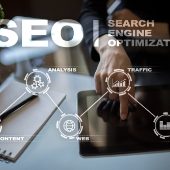 Did you know that images not only make your website more attractive and engaging to customers, but they’re also important for your site’s SEO? If optimized correctly, images can improve your site’s page loading speed and search engine ranking. Here are some tips for optimizing website images.
Did you know that images not only make your website more attractive and engaging to customers, but they’re also important for your site’s SEO? If optimized correctly, images can improve your site’s page loading speed and search engine ranking. Here are some tips for optimizing website images.
What is image optimization?
Image optimization is the process of delivering images in the correct size, format, resolution, and dimension without compromising their quality. The goal is to improve the loading speed of websites to give visitors a better browsing experience.
How to optimize website images
Here are helpful tips for optimizing the images on your website.
1. Choose the correct file format
Digital images come in various formats, but the three most commonly used types for websites are:
- JPEGs – JPEGs are the most widely used format for website images because they have an enormous color palette that’s ideal for showing off images with complex patterns, gradients, shadows, and colors.
- PNGs – PNGs support a wider range of colors compared to JPEGS, making them ideal for images with more complex designs. PNGs are also the only format that can support transparent backgrounds perfect for logos and vector images. The only drawback is that PNG files are larger than JPEGs, which can make page loading times longer.
- GIFs – GIFs are hugely popular as animated memes on social media sites but are hardly used for static images on most websites because of the limited colors — only 256 — they support.
Therefore, they are the best option for small images that require only a few colors.
2. Name your images properly
It’s important to use relevant keywords when naming your website images because search engines like Google not only crawl the text on your website but also crawl image file names. Using keyword-rich and descriptive image file names will allow search engines to provide more accurate results to customers looking for a particular product or service.
For example, if your website is selling used cars, naming an image Red-Ford-Mustang-LX-2012.jpg will get more search results compared to a generic file name like used-car.jpg or DCIMIMAGE001.jpg.
3. Use alt tags
Alt tags are texts that appear in place of a website image that fails to load on a user’s screen. These tags allow screen-reading tools to describe website pictures to visually impaired visitors. In addition, alt tags help search engines crawl and rank your site better. Most of the time, alt tags are almost similar to image file names.
4. Resize your images
Using the wrong image size on your site can negatively impact loading times. For example, featured images in WordPress are usually 1200 x 628 pixels. Images larger than 1200 x 628 pixels will decrease the loading speed of your site. This can lead to high abandonment rates.
5. Compress your images
Image compression is the process of reducing an image’s file size without compromising its quality. This allows you to use more images on your site. The smaller image file size also helps in reducing the time needed to download or send an image over the internet.
Image optimization is a vital part of building a successful website. If you want to learn more about optimizing website images, give our experts a call today.



